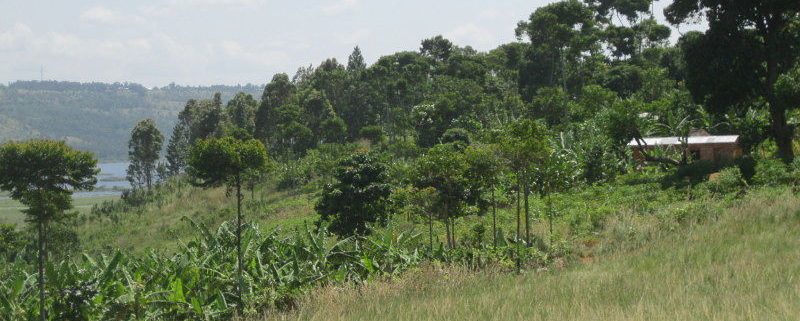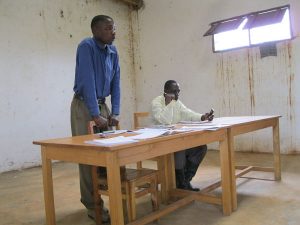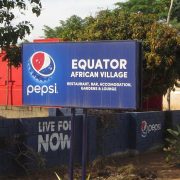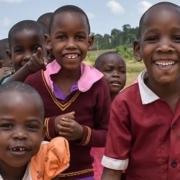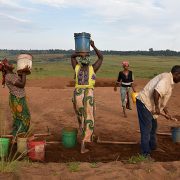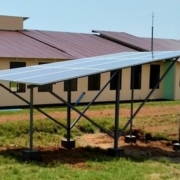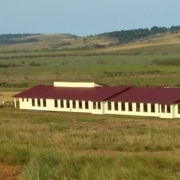Trip Notes from Bushasha Village
We arrived in the village on Saturday afternoon to an enthusiastic welcome from Michael’s family. We spent the rest of that day visiting, and enjoying a delicious meal of cooked green bananas and fish, two very common foods in the Bukoba region. Although the village is right on the shore of Lake Victoria, most of the fish we ate came from the market in town. Fishing was once a mainstay of the village economy, but we were told that fish are now rather hard to come by because stocks in the lake have been so badly depleted.
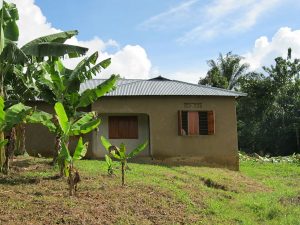 Solar power
Solar power
The house we stayed in—which is the house we plan to use for volunteers once we begin construction—has two solar panels on the roof supplying lights throughout the home. When Michael and I last visited the solar power had not yet been installed, so we were dependent on flashlights and kerosene lanterns. Now we realize how incredibly much more convenient life is with reliable lighting. We felt sorry when we visited a neighbor one evening and saw their high-school age children struggling to study by the dim light of a smelly homemade kerosene lantern, but this is the norm for most children in Bushasha.
Site measurements
 One of the primary tasks we had set for ourselves while in the village was to take more precise measurements of the slopes on the school site. Bill brought along a story pole and laser for this purpose. We spent a number of very hot hours on the site with this equipment gathering data for the architects to use in determining the best placement of the school buildings and teachers’ houses. Our first day taking measurements on the site was a Sunday, when kids were out of school, so our activities attracted a crowd of curious young onlookers (many still wearing their “Sunday best” clothes).
One of the primary tasks we had set for ourselves while in the village was to take more precise measurements of the slopes on the school site. Bill brought along a story pole and laser for this purpose. We spent a number of very hot hours on the site with this equipment gathering data for the architects to use in determining the best placement of the school buildings and teachers’ houses. Our first day taking measurements on the site was a Sunday, when kids were out of school, so our activities attracted a crowd of curious young onlookers (many still wearing their “Sunday best” clothes).
Government requirements
Our other big task was to work our way through the many government steps required before we are allowed to start constructing a school. This meant quite a few trips back and forth to town visiting government offices, a long session with village officials to complete some additional government paperwork, and another visit to the site with a surveyor from the government Land Office. We also had to open a bank account for the subsidiary organization that CORE Tanzania has formed within Tanzania to own the school and manage daily operations.
Village support
All these tasks crammed into one week didn’t leave us with as much time as we would have liked to spend talking with villagers, getting their views about education and about the prospect of a new school in the village. Nevertheless, we did manage to get some input. For example, one afternoon we were walking back from a visit to a relative’s house and a young man working in his garden greeted us and started a conversation. He brought up the topic of the school, and said he’s looking forward to the positive effects that the new school will have on the entire village. We also got further confirmation of the inadequacy of the existing primary school in the village, Kyembale Primary, from neighbors who told us that they don’t know of a single child ever graduating from the local primary school with test scores high enough to gain them admission to a government secondary school. Instead, graduates of Kyembale attend the “community” secondary school five miles down the road from Bushasha. This school faces many of the same issues faced by the local primary school, and struggles to provide a decent education.
Existing school
 We made sure we found time to visit the existing primary school since Bill wanted to see the teacher housing and we also wanted to visit the kindergarten class. We were surprised to learn that since our last visit in June there was a new principal. When we told him about our project, he was very supportive. In fact, he said he would love if we could open the new school next year and start with three classes instead of just one, to take the pressure of high numbers off Kyembale. After he took us to see the kindergarten classroom we understood his sense of urgency—two hundred kids on the roster for one classroom and one government-supplied teacher!
We made sure we found time to visit the existing primary school since Bill wanted to see the teacher housing and we also wanted to visit the kindergarten class. We were surprised to learn that since our last visit in June there was a new principal. When we told him about our project, he was very supportive. In fact, he said he would love if we could open the new school next year and start with three classes instead of just one, to take the pressure of high numbers off Kyembale. After he took us to see the kindergarten classroom we understood his sense of urgency—two hundred kids on the roster for one classroom and one government-supplied teacher!

